Editor's note: Peter Bergen is CNN's national security analyst, a director at the New America Foundation and the author of "Manhunt: The Ten-Year Search for bin Laden -- From 9/11 to Abbottabad."
(CNN) -- Nothing gets conspiracy theorists going more than a passenger plane crashing under mysterious circumstances.
In the absence of hard information to explain such disasters, people look for answers, and the disappearance of Malaysia Airlines Flight 370 early Saturday could prompt the same response.
TWA Flight 800 fell out of the sky on July 17, 1996, shortly after leaving JFK International Airport, killing all 230 people on board.
 Peter Bergen
Peter Bergen Recovery and investigative efforts were hampered because TWA 800 went down in the Atlantic.
Some soon posited that terrorists armed with surface-to-air missiles had brought down the plane.
This theory seemed to be bolstered by eyewitness accounts such as that provided by Naneen Levine, who said she saw something streaking up toward the doomed plane. "I thought it was something on the beach going straight up."
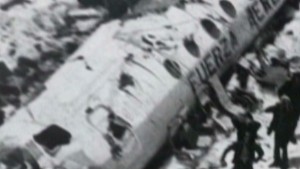 Is Flight 370 similar to past mysteries?
Is Flight 370 similar to past mysteries? Three months after the TWA crash, former ABC News correspondent Pierre Salinger, who had once been President John Kennedy's press secretary, weighed in at a news conference that a U.S. Navy ship had brought down TWA 800 with a missile. Salinger came to this conclusion because of a document on the Internet making this claim.
Bob Francis, the former vice chairman of the National Transportation Safety Board, said of Salinger, "He was an idiot. ... He didn't know what he was talking about, and he was totally irresponsible."
.cnnArticleGalleryNav{border:1px solid #000;cursor:pointer;float:left;height:25px;text-align:center;width:25px} .cnnArticleGalleryNavOn{background-color:#C03;border:1px solid #000;float:left;height:25px;text-align:center;width:20px} .cnnArticleGalleryNavDisabled{background-color:#222;border:1px solid #000;color:#666;float:left;height:25px;text-align:center;width:25px} .cnnArticleExpandableTarget{background-color:#000;display:none;position:absolute} .cnnArticlePhotoContainer{height:122px;width:214px} .cnnArticleBoxImage{cursor:pointer;height:122px;padding-top:0;width:214px} .cnnArticleGalleryCaptionControl{background-color:#000;color:#FFF} .cnnArticleGalleryCaptionControlText{cursor:pointer;float:right;font-size:10px;padding:3px 10px 3px 3px} .cnnArticleGalleryPhotoContainer cite{background:none repeat scroll 0 0 #000;bottom:48px;color:#FFF;height:auto;left:420px;opacity:.7;position:absolute;width:200px;padding:10px} .cnnArticleGalleryClose{background-color:#fff;display:block;text-align:right} .cnnArticleGalleryCloseButton{cursor:pointer} .cnnArticleGalleryNavPrevNext span{background-color:#444;color:#CCC;cursor:pointer;float:left;height:23px;text-align:center;width:26px;padding:4px 0 0} .cnnArticleGalleryNavPrevNextDisabled span{background-color:#444;color:#666;float:left;height:23px;text-align:center;width:25px;padding:4px 0 0} .cnnVerticalGalleryPhoto{padding-right:68px;width:270px;margin:0 auto} .cnnGalleryContainer{float:left;clear:left;margin:0 0 20px;padding:0 0 0 10px}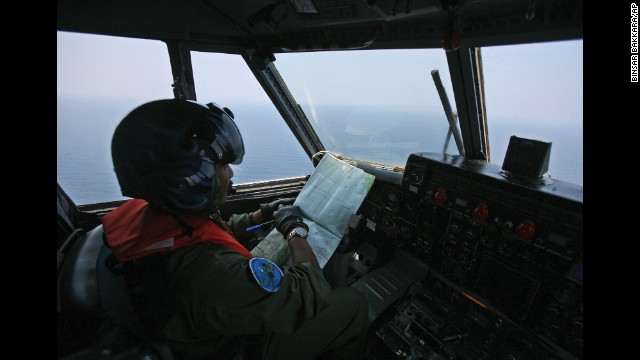 An Indonesian Navy pilot, flying over the waters bordering Indonesia, Malaysia and Thailand near the Strait of Malacca, checks his map during a search operation for the missing Malaysia Airlines jet on Monday, March 10. Contact with the Boeing 777-200 was lost as it flew over the South China Sea early Saturday after leaving Kuala Lumpur for Beijing. It was carrying 227 passengers and 12 crew members. An Indonesian Navy crew member scans the water bordering Indonesia, Malaysia and Thailand on March 10. Vietnam Air Force Col. Le Huu Hanh is reflected on the navigation control panel of a plane that is part of the search operation over the South China Sea on March 10. Relatives of the missing flight's passengers wait in a Beijing hotel room on March 10. A U.S. Navy Seahawk helicopter lands aboard the USS Pinckney to change crews before returning to search for the missing plane Sunday, March 9, in the Gulf of Thailand. Members of the Fo Guang Shan rescue team offer a special prayer March 9 at Kuala Lumpur International Airport in Sepang, Malaysia. A handout picture provided by the Malaysian Maritime Enforcement Agency shows personnel checking a radar screen during search-and-rescue operations March 9. Italian tourist Luigi Maraldi, who reported his passport stolen in August, shows his current passport during a news conference at a police station in Phuket island, Thailand, on March 9. Two passengers on the missing Malaysia Airlines flight were reportedly traveling on stolen passports belonging to Maraldi and an Austrian citizen whose papers were stolen two years ago. Hugh Dunleavy, commercial director of Malaysia Airlines, speaks to journalists March 9 at a Beijing hotel where relatives and friends of the missing flight's passengers are staying. Vietnamese air force crew stand in front of a plane at Tan Son Nhat airport in Ho Chi Minh City, Vietnam, on March 9 before heading out to the area between Vietnam and Malaysia where the airliner vanished early Saturday. Buddhist monks at Kuala Lumpur International Airport offer a special prayer for the missing passengers on March 9. The Chinese navy warship Jinggangshan prepares to leave Zhanjiang Port early on March 9 to assist in search-and-rescue operations for the missing Malaysia Airlines flight. The Jinggangshan, an amphibious landing ship, is loaded with lifesaving equipment, underwater detection devices and supplies of oil, water and food. Members of a Chinese emergency response team board a rescue vessel at the port of Sanya in China's Hainan province on March 9. The vessel is carrying 12 divers and will rendezvous with another rescue vessel on its way to the area where contact was lost with Malaysia Airlines Flight 370. The rescue vessel sets out from Sanya in the South China Sea. A family member of missing passengers is mobbed by journalists at Kuala Lumpur International Airport on Saturday, March 8. A Vietnamese air force plane found traces of oil that authorities had suspected to be from the missing Malaysia Airlines plane, the Vietnamese government online newspaper reported March 8. However, a sample from the slick showed it was bunker oil, typically used to power large cargo ships, Malaysia's state news agency, Bernama, reported on March 10. Malaysian Prime Minister Najib Razak, center, arrives to meet family members of missing passengers at the reception center at Kuala Lumpur International Airport on March 8. Malaysia Airlines official Joshua Law Kok Hwa, center, speaks to reporters in Beijing on March 8. A relative of two missing passengers reacts at their home in Kuala Lumpur on March 8. Wang Yue, director of marketing of Malaysia Airlines in China, reads a company statement during a news conference at the Metro Park Lido Hotel in Beijing on March 8. Chinese police at the Beijing airport stand beside the arrival board showing delayed Flight 370 in red on March 8. A woman asks a staff member at the Beijing airport for more information on the missing flight. A Malaysian man who says he has relatives on board the missing plane talks to journalists at the Beijing airport on March 8. Passengers walk past a Malaysia Airlines sign on March 8 at Kuala Lumpur International Airport. Malaysia Airlines Group CEO Ahmad Juahari Yahya, front, speaks during a news conference on March 8 at a hotel in Sepang. "We deeply regret that we have lost all contacts" with the jet, he said. Malaysia airliner loses contact Malaysia airliner loses contact Malaysia airliner loses contact Malaysia airliner loses contact Malaysia airliner loses contact Malaysia airliner loses contact Malaysia airliner loses contact Malaysia airliner loses contact Malaysia airliner loses contact Malaysia airliner loses contact Malaysia airliner loses contact Malaysia airliner loses contact Malaysia airliner loses contact Malaysia airliner loses contact Malaysia airliner loses contact Malaysia airliner loses contact Malaysia airliner loses contact Malaysia airliner loses contact Malaysia airliner loses contact Malaysia airliner loses contact Malaysia airliner loses contact Malaysia airliner loses contact Malaysia airliner loses contact Malaysia airliner loses contact Malaysia airliner loses contact HIDE CAPTION << <
An Indonesian Navy pilot, flying over the waters bordering Indonesia, Malaysia and Thailand near the Strait of Malacca, checks his map during a search operation for the missing Malaysia Airlines jet on Monday, March 10. Contact with the Boeing 777-200 was lost as it flew over the South China Sea early Saturday after leaving Kuala Lumpur for Beijing. It was carrying 227 passengers and 12 crew members. An Indonesian Navy crew member scans the water bordering Indonesia, Malaysia and Thailand on March 10. Vietnam Air Force Col. Le Huu Hanh is reflected on the navigation control panel of a plane that is part of the search operation over the South China Sea on March 10. Relatives of the missing flight's passengers wait in a Beijing hotel room on March 10. A U.S. Navy Seahawk helicopter lands aboard the USS Pinckney to change crews before returning to search for the missing plane Sunday, March 9, in the Gulf of Thailand. Members of the Fo Guang Shan rescue team offer a special prayer March 9 at Kuala Lumpur International Airport in Sepang, Malaysia. A handout picture provided by the Malaysian Maritime Enforcement Agency shows personnel checking a radar screen during search-and-rescue operations March 9. Italian tourist Luigi Maraldi, who reported his passport stolen in August, shows his current passport during a news conference at a police station in Phuket island, Thailand, on March 9. Two passengers on the missing Malaysia Airlines flight were reportedly traveling on stolen passports belonging to Maraldi and an Austrian citizen whose papers were stolen two years ago. Hugh Dunleavy, commercial director of Malaysia Airlines, speaks to journalists March 9 at a Beijing hotel where relatives and friends of the missing flight's passengers are staying. Vietnamese air force crew stand in front of a plane at Tan Son Nhat airport in Ho Chi Minh City, Vietnam, on March 9 before heading out to the area between Vietnam and Malaysia where the airliner vanished early Saturday. Buddhist monks at Kuala Lumpur International Airport offer a special prayer for the missing passengers on March 9. The Chinese navy warship Jinggangshan prepares to leave Zhanjiang Port early on March 9 to assist in search-and-rescue operations for the missing Malaysia Airlines flight. The Jinggangshan, an amphibious landing ship, is loaded with lifesaving equipment, underwater detection devices and supplies of oil, water and food. Members of a Chinese emergency response team board a rescue vessel at the port of Sanya in China's Hainan province on March 9. The vessel is carrying 12 divers and will rendezvous with another rescue vessel on its way to the area where contact was lost with Malaysia Airlines Flight 370. The rescue vessel sets out from Sanya in the South China Sea. A family member of missing passengers is mobbed by journalists at Kuala Lumpur International Airport on Saturday, March 8. A Vietnamese air force plane found traces of oil that authorities had suspected to be from the missing Malaysia Airlines plane, the Vietnamese government online newspaper reported March 8. However, a sample from the slick showed it was bunker oil, typically used to power large cargo ships, Malaysia's state news agency, Bernama, reported on March 10. Malaysian Prime Minister Najib Razak, center, arrives to meet family members of missing passengers at the reception center at Kuala Lumpur International Airport on March 8. Malaysia Airlines official Joshua Law Kok Hwa, center, speaks to reporters in Beijing on March 8. A relative of two missing passengers reacts at their home in Kuala Lumpur on March 8. Wang Yue, director of marketing of Malaysia Airlines in China, reads a company statement during a news conference at the Metro Park Lido Hotel in Beijing on March 8. Chinese police at the Beijing airport stand beside the arrival board showing delayed Flight 370 in red on March 8. A woman asks a staff member at the Beijing airport for more information on the missing flight. A Malaysian man who says he has relatives on board the missing plane talks to journalists at the Beijing airport on March 8. Passengers walk past a Malaysia Airlines sign on March 8 at Kuala Lumpur International Airport. Malaysia Airlines Group CEO Ahmad Juahari Yahya, front, speaks during a news conference on March 8 at a hotel in Sepang. "We deeply regret that we have lost all contacts" with the jet, he said. Malaysia airliner loses contact Malaysia airliner loses contact Malaysia airliner loses contact Malaysia airliner loses contact Malaysia airliner loses contact Malaysia airliner loses contact Malaysia airliner loses contact Malaysia airliner loses contact Malaysia airliner loses contact Malaysia airliner loses contact Malaysia airliner loses contact Malaysia airliner loses contact Malaysia airliner loses contact Malaysia airliner loses contact Malaysia airliner loses contact Malaysia airliner loses contact Malaysia airliner loses contact Malaysia airliner loses contact Malaysia airliner loses contact Malaysia airliner loses contact Malaysia airliner loses contact Malaysia airliner loses contact Malaysia airliner loses contact Malaysia airliner loses contact Malaysia airliner loses contact HIDE CAPTION << <  1
1  2
2  3
3  4
4  5
5  6
6  7
7  8
8  9
9  10
10  11
11  12
12  13
13  14
14  15
15  16
16  17
17  18
18  19
19  20
20  21
21  22
22  23
23  24
24  25 > >>
25 > >>  Photos: Malaysia airliner loses contact
Photos: Malaysia airliner loses contact Opinion: Why so few clues about missing Malaysia flight?
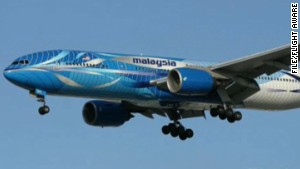 Quest: Odd to lose contact while cruising
Quest: Odd to lose contact while cruising 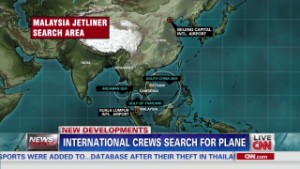 International crews search for plane
International crews search for plane 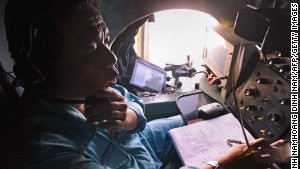 Questions swirl after airliner vanishes
Questions swirl after airliner vanishes After a four-year investigation, the NTSB ruled that the TWA 800 crash was caused by "an explosion of the center wing fuel tank, resulting from ignition of the flammable fuel/air mixture in the tank."
Three years after TWA 800 went down, EgyptAir Flight 990 left JFK International and soon plunged into the Atlantic, killing more than 200 people on board.
Two competing theories about what happened emerged. The NTSB, widely regarded around the world as the most authoritative investigator of plane crashes, concluded after a three-year investigation that one of the Egyptian pilots, Gameel al-Batouti, had intentionally downed the plane.
NTSB pointed to the fact that the downward trajectory of the plane was inconsistent with mechanical failure. Based on the recovered cockpit voice recorder, NTSB also underlined al-Batouti's constant use of the phrase, "I rely on God," and his lack of surprise when the passenger jet suddenly began descending.
In Egypt, this was not a popular view, and Egyptian officials pointed to supposed mechanical failure as the cause of the crash.
The conspiracy theories that developed around TWA 800 were caused by unreliable eyewitness accounts and Internet rumor-mongering. In the case of EgyptAir 900, Egyptian officials would not accept that an Egyptian pilot would commit suicide, killing many others, and came up with an alternative explanation for which there was scant evidence.
In the case of the downing of Pan Am Flight 103, there was a deliberate effort to inject a conspiracy theory into the narrative of the events.
Pan Am 103 blew up over Scotland on December 21, 1988, because of a bomb in the hold, which killed 270 on board and others on the ground.
Juval Aviv, who presented himself as a former Israeli counterterrorism official, was hired by Pan Am to investigate what happened.
In his report, Aviv claimed to have proof that the murder of the passengers on Pan Am 103 was the result of a CIA sting operation that went awry, an assertion for which there was not a shred of evidence.
Yet a piece partly based on Aviv's fairy tale then ended up as a cover story in TIME magazine. The U.S. government later concluded that the attack was ordered by the Libyan government, something the Libyans would eventually concede was, in fact, true.
The TWA 800, EgyptAir 990 and Pan Am 103 cases represent the likely range of reasons that brought down Malaysia Airlines Flight 370: mechanical failure, pilot actions or terrorism.
Based on these past cases, we should be careful not to allow conspiracy theories about what happened to get too much play. The truth will come out only after a careful and lengthy investigation.
Follow us on Twitter @CNNOpinion.
Join us on Facebook/CNNOpinion.
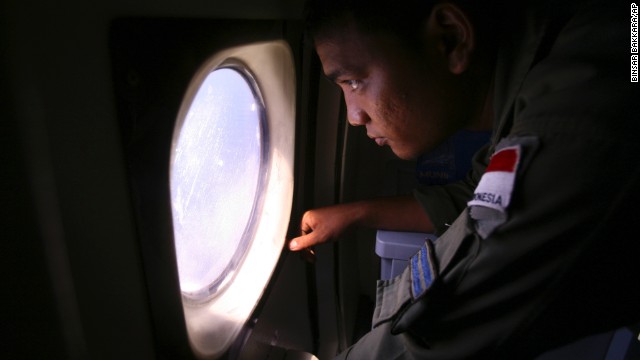 An Indonesian Navy crew member scans the water bordering Indonesia, Malaysia and Thailand on March 10.
An Indonesian Navy crew member scans the water bordering Indonesia, Malaysia and Thailand on March 10. 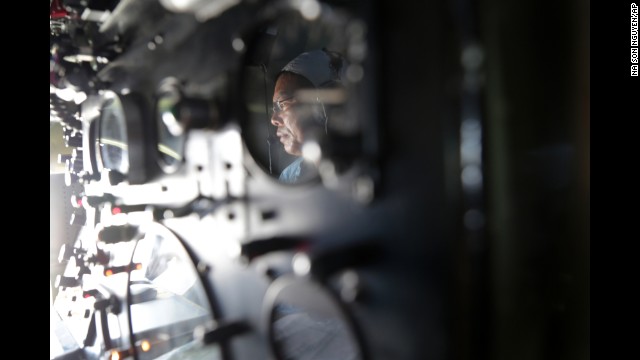 Vietnam Air Force Col. Le Huu Hanh is reflected on the navigation control panel of a plane that is part of the search operation over the South China Sea on March 10.
Vietnam Air Force Col. Le Huu Hanh is reflected on the navigation control panel of a plane that is part of the search operation over the South China Sea on March 10.  Relatives of the missing flight's passengers wait in a Beijing hotel room on March 10.
Relatives of the missing flight's passengers wait in a Beijing hotel room on March 10. 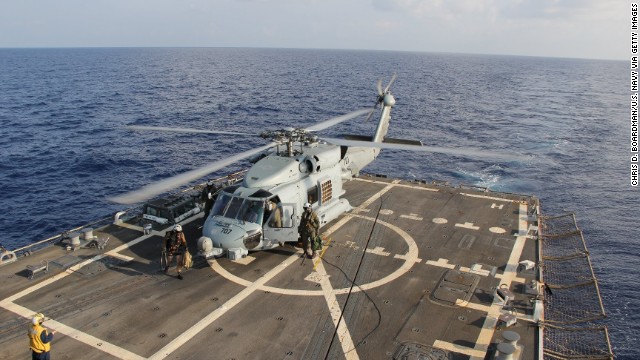 A U.S. Navy Seahawk helicopter lands aboard the USS Pinckney to change crews before returning to search for the missing plane Sunday, March 9, in the Gulf of Thailand.
A U.S. Navy Seahawk helicopter lands aboard the USS Pinckney to change crews before returning to search for the missing plane Sunday, March 9, in the Gulf of Thailand.  Members of the Fo Guang Shan rescue team offer a special prayer March 9 at Kuala Lumpur International Airport in Sepang, Malaysia.
Members of the Fo Guang Shan rescue team offer a special prayer March 9 at Kuala Lumpur International Airport in Sepang, Malaysia.  A handout picture provided by the Malaysian Maritime Enforcement Agency shows personnel checking a radar screen during search-and-rescue operations March 9.
A handout picture provided by the Malaysian Maritime Enforcement Agency shows personnel checking a radar screen during search-and-rescue operations March 9.  Italian tourist Luigi Maraldi, who reported his passport stolen in August, shows his current passport during a news conference at a police station in Phuket island, Thailand, on March 9. Two passengers on the missing Malaysia Airlines flight were reportedly traveling on stolen passports belonging to Maraldi and an Austrian citizen whose papers were stolen two years ago.
Italian tourist Luigi Maraldi, who reported his passport stolen in August, shows his current passport during a news conference at a police station in Phuket island, Thailand, on March 9. Two passengers on the missing Malaysia Airlines flight were reportedly traveling on stolen passports belonging to Maraldi and an Austrian citizen whose papers were stolen two years ago.  Hugh Dunleavy, commercial director of Malaysia Airlines, speaks to journalists March 9 at a Beijing hotel where relatives and friends of the missing flight's passengers are staying.
Hugh Dunleavy, commercial director of Malaysia Airlines, speaks to journalists March 9 at a Beijing hotel where relatives and friends of the missing flight's passengers are staying. 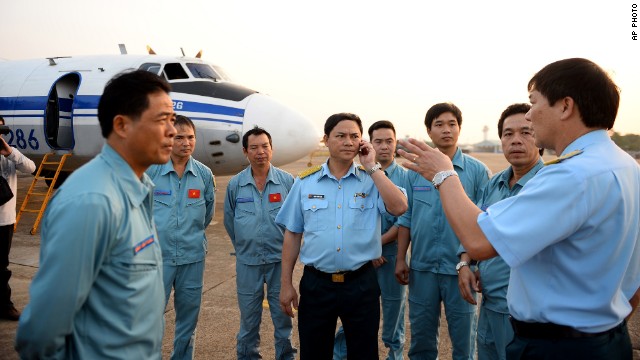 Vietnamese air force crew stand in front of a plane at Tan Son Nhat airport in Ho Chi Minh City, Vietnam, on March 9 before heading out to the area between Vietnam and Malaysia where the airliner vanished early Saturday.
Vietnamese air force crew stand in front of a plane at Tan Son Nhat airport in Ho Chi Minh City, Vietnam, on March 9 before heading out to the area between Vietnam and Malaysia where the airliner vanished early Saturday.  Buddhist monks at Kuala Lumpur International Airport offer a special prayer for the missing passengers on March 9.
Buddhist monks at Kuala Lumpur International Airport offer a special prayer for the missing passengers on March 9. 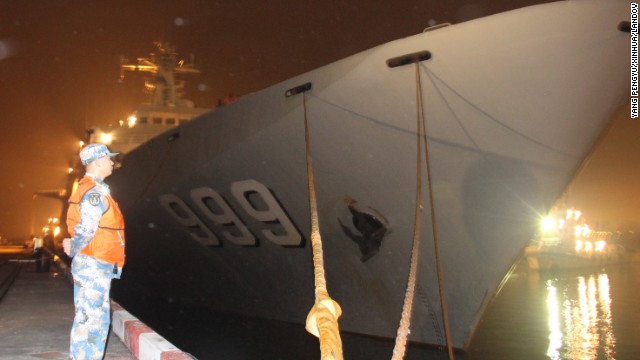 The Chinese navy warship Jinggangshan prepares to leave Zhanjiang Port early on March 9 to assist in search-and-rescue operations for the missing Malaysia Airlines flight. The Jinggangshan, an amphibious landing ship, is loaded with lifesaving equipment, underwater detection devices and supplies of oil, water and food.
The Chinese navy warship Jinggangshan prepares to leave Zhanjiang Port early on March 9 to assist in search-and-rescue operations for the missing Malaysia Airlines flight. The Jinggangshan, an amphibious landing ship, is loaded with lifesaving equipment, underwater detection devices and supplies of oil, water and food. 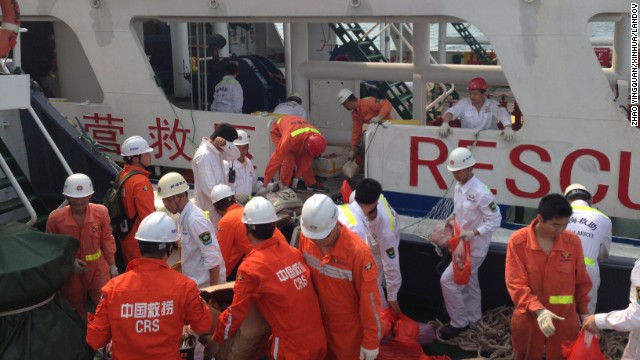 Members of a Chinese emergency response team board a rescue vessel at the port of Sanya in China's Hainan province on March 9. The vessel is carrying 12 divers and will rendezvous with another rescue vessel on its way to the area where contact was lost with Malaysia Airlines Flight 370.
Members of a Chinese emergency response team board a rescue vessel at the port of Sanya in China's Hainan province on March 9. The vessel is carrying 12 divers and will rendezvous with another rescue vessel on its way to the area where contact was lost with Malaysia Airlines Flight 370. 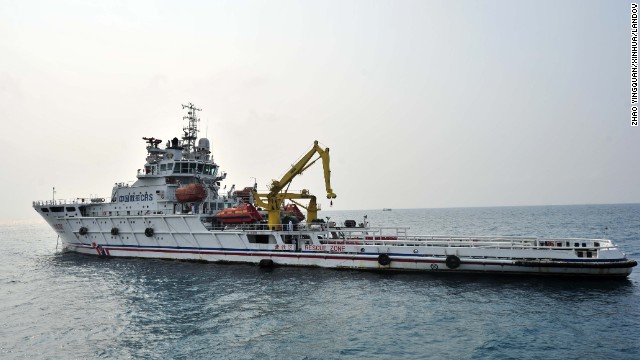 The rescue vessel sets out from Sanya in the South China Sea.
The rescue vessel sets out from Sanya in the South China Sea.  A family member of missing passengers is mobbed by journalists at Kuala Lumpur International Airport on Saturday, March 8.
A family member of missing passengers is mobbed by journalists at Kuala Lumpur International Airport on Saturday, March 8.  A Vietnamese air force plane found traces of oil that authorities had suspected to be from the missing Malaysia Airlines plane, the Vietnamese government online newspaper reported March 8. However, a sample from the slick showed it was bunker oil, typically used to power large cargo ships, Malaysia's state news agency, Bernama, reported on March 10.
A Vietnamese air force plane found traces of oil that authorities had suspected to be from the missing Malaysia Airlines plane, the Vietnamese government online newspaper reported March 8. However, a sample from the slick showed it was bunker oil, typically used to power large cargo ships, Malaysia's state news agency, Bernama, reported on March 10. 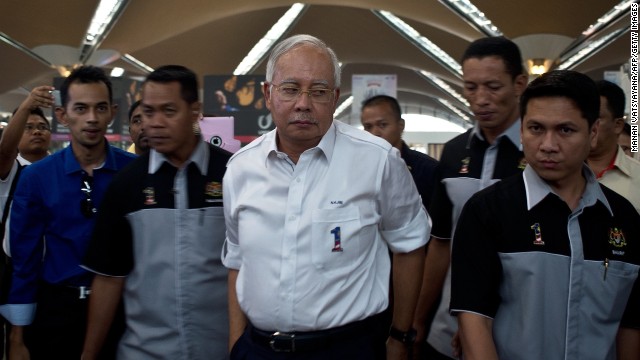 Malaysian Prime Minister Najib Razak, center, arrives to meet family members of missing passengers at the reception center at Kuala Lumpur International Airport on March 8.
Malaysian Prime Minister Najib Razak, center, arrives to meet family members of missing passengers at the reception center at Kuala Lumpur International Airport on March 8.  Malaysia Airlines official Joshua Law Kok Hwa, center, speaks to reporters in Beijing on March 8.
Malaysia Airlines official Joshua Law Kok Hwa, center, speaks to reporters in Beijing on March 8.  A relative of two missing passengers reacts at their home in Kuala Lumpur on March 8.
A relative of two missing passengers reacts at their home in Kuala Lumpur on March 8.  Wang Yue, director of marketing of Malaysia Airlines in China, reads a company statement during a news conference at the Metro Park Lido Hotel in Beijing on March 8.
Wang Yue, director of marketing of Malaysia Airlines in China, reads a company statement during a news conference at the Metro Park Lido Hotel in Beijing on March 8. 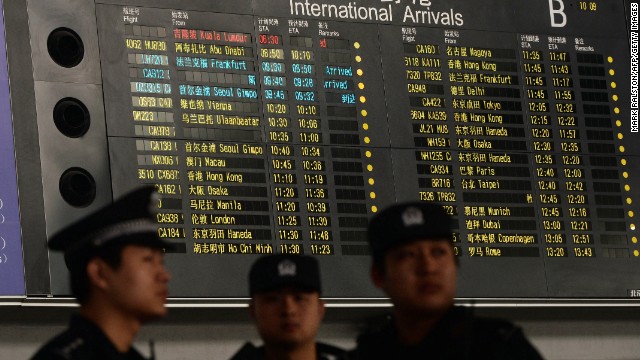 Chinese police at the Beijing airport stand beside the arrival board showing delayed Flight 370 in red on March 8.
Chinese police at the Beijing airport stand beside the arrival board showing delayed Flight 370 in red on March 8. 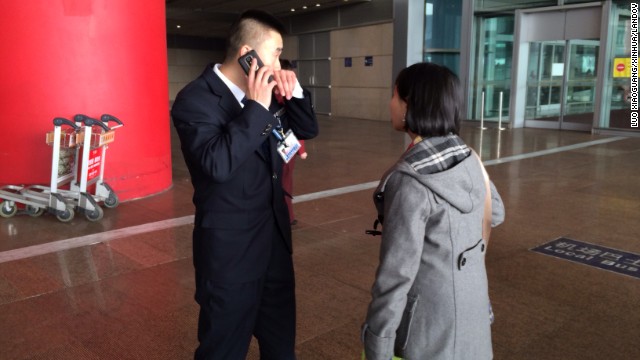 A woman asks a staff member at the Beijing airport for more information on the missing flight.
A woman asks a staff member at the Beijing airport for more information on the missing flight.  A Malaysian man who says he has relatives on board the missing plane talks to journalists at the Beijing airport on March 8.
A Malaysian man who says he has relatives on board the missing plane talks to journalists at the Beijing airport on March 8.  Passengers walk past a Malaysia Airlines sign on March 8 at Kuala Lumpur International Airport.
Passengers walk past a Malaysia Airlines sign on March 8 at Kuala Lumpur International Airport.  Malaysia Airlines Group CEO Ahmad Juahari Yahya, front, speaks during a news conference on March 8 at a hotel in Sepang. "We deeply regret that we have lost all contacts" with the jet, he said. Malaysia airliner loses contact Malaysia airliner loses contact Malaysia airliner loses contact Malaysia airliner loses contact Malaysia airliner loses contact Malaysia airliner loses contact Malaysia airliner loses contact Malaysia airliner loses contact Malaysia airliner loses contact Malaysia airliner loses contact Malaysia airliner loses contact Malaysia airliner loses contact Malaysia airliner loses contact Malaysia airliner loses contact Malaysia airliner loses contact Malaysia airliner loses contact Malaysia airliner loses contact Malaysia airliner loses contact Malaysia airliner loses contact Malaysia airliner loses contact Malaysia airliner loses contact Malaysia airliner loses contact Malaysia airliner loses contact Malaysia airliner loses contact Malaysia airliner loses contact HIDE CAPTION << <
Malaysia Airlines Group CEO Ahmad Juahari Yahya, front, speaks during a news conference on March 8 at a hotel in Sepang. "We deeply regret that we have lost all contacts" with the jet, he said. Malaysia airliner loses contact Malaysia airliner loses contact Malaysia airliner loses contact Malaysia airliner loses contact Malaysia airliner loses contact Malaysia airliner loses contact Malaysia airliner loses contact Malaysia airliner loses contact Malaysia airliner loses contact Malaysia airliner loses contact Malaysia airliner loses contact Malaysia airliner loses contact Malaysia airliner loses contact Malaysia airliner loses contact Malaysia airliner loses contact Malaysia airliner loses contact Malaysia airliner loses contact Malaysia airliner loses contact Malaysia airliner loses contact Malaysia airliner loses contact Malaysia airliner loses contact Malaysia airliner loses contact Malaysia airliner loses contact Malaysia airliner loses contact Malaysia airliner loses contact HIDE CAPTION << <
{ 0 comments... read them below or add one }
Post a Comment